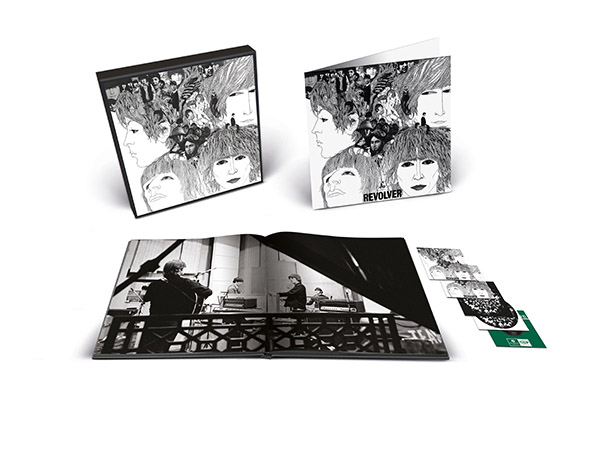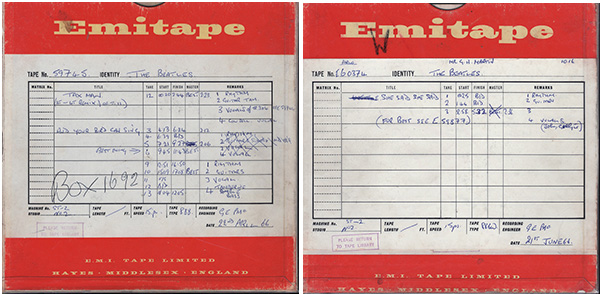| Columns Retired Columns & Blogs |
Loved every word. Yours and his. Thank you.

On a warm day in September 2022, alongside 40 or so press colleagues, I was treated to an advance demonstration of the Dolby Atmos mix of The Beatles' Revolver, at Republic Studios on Broadway In New York City's midtown. Producer/mixer Giles Martin—son of original Beatles producer Sir George Martin—was our host. Giles Martin's demeanor was self-deprecating, and he seemed to know all there is to know about the Beatles and their productions. As Martin played songs from Revolver in surround sound, the assembled group seemed amazed by what they heard.
Played through a JBL-based 7.1.4 system in a conference room (footnote 1), "Tomorrow Never Knows," Revolver's final track (which, however, was the first to be recorded), was transformed. Based on texts from The Psychedelic Experience: A Manual Based on the Tibetan Book of the Dead and employing radical elements including musique concrète, avant-garde composition, and tape loops, the effect of this new, spacious soundfield—on an album known for its claustrophobic production—was shocking. At the front of the mix, Lennon's vocal was large; it came across with more texture and nuance than I'd ever heard.
Also, up front, Paul's woozy electric bass and Ringo's cracking drums had weight and viscosity; Ringo's familiar 16th note, mounted-tom strike ("da-doom") now revealed a pitch dip, indicating that he'd tuned the drum's bottom head lower and looser than its top head.
When the song's legendary effects came in, all hell broke loose, recalling emotions similar to those I felt when, as a child, I first saw Linda Blair's head spin 360 degrees in 1973's The Exorcist. (But this was the Beatles, so I knew we were safe.) Seagulls screamed overhead, flying front to back. What sounded like Mellotrons and calliopes looped maniacally from left to right, as if laughing. Massed strings collided and crashed. Tambura droned. George Harrison's strangled, backward electric guitars squirmed above me—then, seemingly, through me—ricocheting off the back wall. Keyboards swirled from left and right like killer hornets; a high-pitched squeal signaled a warning. This was rock music as furnace-heated blast, as white-hot sensory overload.

Though perhaps less intense, a similarly new experience awaits buyers of any of the three Revolver: Special Edition packages. "Here, There and Everywhere" has previously unheard vocal finesse and layering. The jackhammer bass and drums on "Taxman" sear. The bracing guitars and harmony vocals of "She Said" take on more space and dimensionality. "Eleanor Rigby" was a total shock, the string quartet punchy and emotive; the lyrics, arrangement, and extreme rhythmic attack expressing not sorrow but anger, maybe disgust. This is not your father's Revolver.
The remixed, expanded Revolver: Special Edition is available in five-CD or four-LP super deluxe sets that include a half-speed remastered stereo mix, the original mono mix, demos and session recordings, a newly remixed EP ("Paperback Writer"/"Rain"), and a 100-page book, "with images of hand-written lyrics, tape boxes, and recording sheets, as well as 1966 print ads." A deluxe edition includes an abridged 40-page version of the book, the new stereo mix, session highlights, and stereo mixes of the singles. Standard single-CD and single-LP album releases are also available, along with digital packages.
Created at Abbey Road Studios by Giles Martin and Sam Okell, production, engineering and mixing; Sean Magee, Thomas Hall, Alex Wharton, and Miles Showell, mastering; the newly remixed and remastered Revolver was released on October 28, 2022, to near-universal praise.
The team used the same artificial intelligence–based "demixing" technology first explored by director Peter Jackson's WingNut team when they made the documentary The Beatles: Get Back. Demixing allowed Martin and crew to reimagine Revolver. The resulting recordings have more detail in voices, instruments, and room sounds; more weight, texture, and dimensionality; and vastly improved dynamics. Perhaps the most profound change is the level of clarity, which brings Revolver, a rather tinny, compressed-sounding album, practically alive in your listening room.

Ken Micallef: What accounts for the fleshed-out mix of the new Revolver? Is it modern technology applied to old tapes?
Giles Martin: It's just good mixing. I'm not adding digitally enhanced frequencies. I am mixing on a digital system. You can't mix from tape into that. But these recordings have depth. We're stripping things back. The difference is what I and Sam Okell do: We take different elements and rerecord them back through Studio Two at Abbey Road. The walls in that room are the walls of Studio Two in Abbey Road, so we can add some room sound to things. We have that element, but that's not a digital effect. That's just me recording something and playing it back.
KM: Did you listen to the original stereo vinyl pressings of Revolver as a gauge?
GM: Of course. I'd listen to the stereo remaster, the original stereo, and the mono. On my system, I have all the mixes lined up. I have a button on my desk, which I can flick between them. If I'm playing the Atmos mix, I'll do the stereo first, then Atmos, and Atmos original stereo, just to make sure I'm not missing anything. I'm not changing the feel of a song. It's more of an emotional thing. How close do you feel to the vocal? What impact do the drums have? It's like remembering a book. It's really important to get that right. It's important that there is a difference but [that] the difference is good.

KM: What was Paul McCartney's response to hearing the new Atmos mixes?
GM: He loved them. The thing I try and do with the band is try and get the listener closer to them, so they feel like they're interacting. I like the idea that you're standing in the vinyl, you're standing in the record, and you start falling into the studio. You suddenly feel as though you are in this record, but not in a gimmicky way. I'm a music fan. I want to feel the drums and feel the guitar. It's the same balance as I've listened to before, but just positionally, it's like being part of the band now.

Loved every word. Yours and his. Thank you.

These new mixes prove that more is not better !

With Apple & Amazon music streaming services providing ATMOS mixes at no extra cost, I can see why the big music labels are jumping on the bandwagon (no pun intended). I hope everyone involved can make money with this!

>>>These new mixes prove that more is not better !<<<
These new mixes prove that more is not worse.